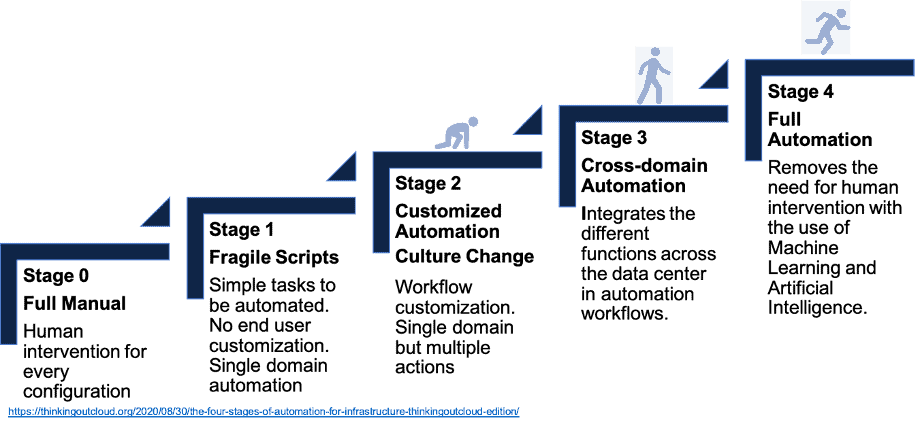
Digital transformation is both an opportunity and a challenge for enterprises seeking greater agility and efficiency to stay competitive in their industries. Often, processes connecting multiple departments are rendered across numerous platforms, so there’s a constant need for accurate and optimal coordination. IT infrastructure orchestration helps alleviate these key pain points while easing the management of complex tasks and workflows.
IT teams are currently managing several vendors and domains to help ensure that processes are being properly executed. Bridging these domains requires a hefty configuration and time-consuming manual labor, adding difficulty to the technological shift and translating to digital transformation fatigue.
The stages and phases below help represent the process leading to Orchestral.ai’s success with automation and orchestration, which eases the digitalization journey itself.

This stage sets the groundwork for some kind of organization and structure process that will allow investments in technologies, facilitating moving away from the limitations and constant inaccuracies engineers are facing. A Stage 0 enterprise usually employs little to no use of scripting and standard APIs causing fixes and bridges to be done manually, in exhausting time-taking labor.
Unlike Stage 0, Stage 1 shows some progress in standard documentation practices outlining a series of scripts that help lower the rate of anomalies in configuration. The scripts, however, lack proper QA, making them prone to failure and unlikely to increase productivity. Maintaining the script is a laborious task as they tend to be highly individualized and there is no automated remediation.
New technologies and platforms are introduced in this stage, allowing proper training for engineers to implement standard documentation practices and improve scripts, reducing the time invested in script maintenance and in fixing inaccuracies found in configurations. Although there is still a lack of automation to help remedy these drifts, the team is now more organized and focused to move past this stage.
Introducing automation to the different functions across all domains forms the foundation for a self-driven approach fueled by standardized documentation and an overall effort to design and implement automation. It is imperative that the IT operations process that is followed to complete a given operation be automated as a series of related tasks and the cross-domain automation platform has the ability to perform these tasks as an automated process workflow.
Stage 4 eliminates the need for human intervention with the use of machine learning and artificial intelligence. Enterprises aiming to be at stage 4 share the same efforts across teams to schedule and pipeline new automation through automation strategy and automated testing. Event-driven automation allows the full self-driven approach mentioned in the previous stage, with the exception that there is no need for human intervention.
The above-mentioned stages are broken into the following three phases based on the technology being used.
Long-drawn processes make way for multiple issues, creating a slower than expected approach towards digital transformation. In this phase, IT teams are manually configuring tasks across domains and independent siloed, domain-specific automation is being performed.
This phase, which we call the ‘Crawl’ phase, brings plenty of manual errors in data and delays due to the heavy human intervention required for all ongoing and incoming configurations. These setbacks not only frustrate IT teams but also may lead to distrust within operator groups and a disgruntled customer.
In this phase, the ‘Walk’, IT teams’ job of bridging tasks and data from different domains is taken over by workflow automation, allowing them to further engage in deciding when to initiate and execute process workflows. Although there is a sense of automation within the process, the decision-making capability is still manual and time-consuming, inhibiting the progress of digitalization.
Bringing in multiple artificial intelligence technologies implemented in an eXplainable AI (XAI) engine combined with the right orchestration tool provides a platform to run a self-driven IT infrastructure.
For the ‘Run’ phase to be delivered effectively, the XAI tools need a trusted remediation workflow engine to execute the decisions made.
To reach optimization in the digitalization journey, businesses must aim to combine the ‘Walk’ and ‘Run’ phase, providing a holistic platform that brings together all the different technologies across all domains.
At Orchestral.ai, we’ve delivered a solution based on an event-driven workflow orchestration engine guided by the XAI engine, which we’d like to call the brawn and the brain of the platform.
The brawn crawls the infrastructure, collecting real-time data which is later guided intelligently by the brain, providing decisions based on these findings and historical data. The combination of the two yields results greater than the sum of the parts; Autonomous Infrastructure.
The brawn is the event-driven workflow orchestration powered by the following tools:
The brain, the Explainable AI engine, is powered by:
Orchestral.ai delivers the Symphony platform enabling Intent-Based Intelligent Infrastructure Orchestration for customers across different industries. This platform allows I&O teams to adopt Agile and DevOps methodologies, enabling digital transformation in their organizations to deliver Autonomous Infrastructure.
Maestro, the next generation XAI Engine, combines the best-of-breed AI technologies of knowledge graphs, decision intelligence with causal inference, and traditional ML-based technologies to deliver a powerful XAI engine purpose-built for IT Infrastructure operations. The explainable interface for the XAI engine is the persona-based multi-layer dashboard which provides analytical and predictive decision-making capabilities.
Composer powered by StackStorm™ provides over 450 available integrations to bridge different infrastructure systems and toolchains. Rules and actions enable Composer to execute hundreds of workflows per second—which speeds up mundane tasks—and can trigger orchestrated actions or workflows to deliver self-driven solutions. The product provides the “Cross-Domain Orchestration” necessary to complete Stage 3 of the automation journey. Additionally, it provides the foundational orchestration functions necessary for the run stage; “Intelligent Orchestration” of the journey.
D3E is a vendor-agnostic data discovery and telemetry engine that provides the requisite data to the Maestro engine to build an AI-based knowledge graph and provides the real-time data to intelligently auto-remediate infrastructure events before it turns into a catastrophe.
Collectively, The Symphony Platform (Maestro, Composer, and D3E) delivers the promise of “Autonomous Infrastructure“. The solution brings to bear Stage 3 and Stage 4 of the automation journey in a single platform. The benefits of a single platform addressing both the stages of the automation journey extend to the areas of Security, Performance, Availability, Reliability, and Cost (SPARC) of the day-to-day operations of the infrastructure.
Intuitively, business leaders across multiple industries all over the world are adopting new tools and technologies to stay competitive, enhance employee engagement, and keep up-to-date with the digital transformation in their companies. In this day and age, it is imperative to adopt Agile and DevOps methodologies to remain relevant and to assure business objectives are accurately delivered.
Orchestral.ai’s Autonomous Infrastructure is not only designed to meet and exceed the expectations previously mentioned, but also mitigate any shortcomings presented in the digitalization journey.
For help on getting started and to begin a 30-day free trial, click here and address your automation and orchestration challenges in an efficient way.